Maldives
sovereign state in South Asia, situated on an archipelago in the Arabian Sea
The Maldives (Dhivehi: ދިވެހިރާއްޖެ Dhivehi Raajje) are an archipelago in the Indian Ocean with picture-perfect beaches, strikingly blue water, and luxury resorts. There are 200 inhabited islands and 154 islands with tourist resorts. Just under the surface of the beautiful blue ocean, there's a wealth of wildlife to see: over 2000 species of fish in all colours of the rainbow roam the clear waters around the islands.
Regions
The Maldives are an archipelago of 1,192 coral islands formed of 26 atolls, or atholhu in Dhivehi — the source of the English word. These are not single islands, but giant ringlike coral formations hundreds of kilometres wide that have fragmented into countless islands.
Atoll naming is complex, as the atolls have both lengthy traditional Dhivehi names like Maalhosmadulu Dhekunuburi, and snappy code names like Baa that refers to administrative regions and may consist of more than one geographical atoll. The code names are the letters of Dhivehi alphabet, but being easier for non-Maldivians to remember and pronounce, the code names are popular in the travel industry and are hence also used here. Of the 21 administrative atoll groups, only (parts of) 10 are open to tourism, and from north to south these are:

| Lhaviyani (Miladhunmadulu Uthuruburi) |
| Raa (Maalhosmadulu Uthuruburi) |
| Baa (Maalhosmadulu Dhekunuburi) |
| Kaafu (North and South Malé Atoll) Site of the capital Malé and the airport, home of most Maldivian resorts. |
| Alifu (Ari) To the west of Kaafu, the second most popular group. |
| Vaavu (Felidhu) |
| Meemu (Mulak) |
| Faafu (Nilandhe Atholhu Uthuruburi) |
| Dhaalu (Nilandhe Atholhu Dhekunuburi) |
| Seenu (Addu) The southernmost atoll, the second-largest in population and site of Gan International Airport. |
The other atolls are Gaafu Alifu, Gaafu Dhaalu, Gnaviyani, Haa Alifu, Noonu, Haa Dhaalu, Laamu, Njyavinani, Shaviyani and Thaa.
Cities
- 🌍 Malé — the capital and by far the largest city, crammed onto a small island and by some measures the world's densest city
- 🌍 Addu — the Maldives' second city in the far south of the archipelago, the former capital of the short-lived United Suvadive Republic
- 🌍 Fuvahmulah — just north of Addu, well off the beaten track
- 🌍 Kulhudhuffushi — largest city in the northern Maldives
Other destinations
- 🌍 Kuredu — one of the inhabited islands of Lhaviyani Atoll
- 🌍 Mathiveri — island belonging to North Ari Atoll
- 🌍 Rasdhoo — smallish inhabited island and the capital of the North Ari Atoll
- 🌍 Thoddoo — an isolated inhabited island that administratively belongs to North Ari Atoll. It's also the largest producer of watermelon in Maldives.
- 🌍 Ukulhas — smallish 1 km long island of Alif Alif Atoll
Understand
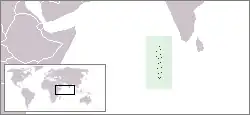 | |
| Capital | Malé |
| Currency | Maldivian rufiyaa (MVR) |
| Population | 436.3 thousand (2017) |
| Electricity | 230 volt / 50 hertz (NEMA 1-15, Europlug, AC power plugs and sockets: British and related types, BS 1363, SEV 1011, Type K, Type L) |
| Country code | +960 |
| Time zone | UTC+05:00, Indian/Maldives |
| Emergencies | 119 (police force), 102 (emergency medical services), 118 (fire department) |
| Driving side | left |
| edit on Wikidata | |
History
The heritage of the Maldives is told in legends, in records of old copperplates, coral-carved ancient scripts and echoes of traditional culture. The story tallies in known South Asian history with mentions of the great Mauryan ruler Emperor Ashoka.
After being a Sultanate under Dutch and British protection, the Maldives gained independence from the British in 1965 and became a republic in 1968. Maumoon Abdul Gayoom ruled over the country with an iron fist and did not hesitate to jail dissidents. He was re-elected five times in more or less rigged elections. Resistance to his rule culminated in violent rioting in 2003 and 2004. Much to everybody's surprise, free and fair elections were held in 2008, and Maumoon conceded defeat to opposition leader Mohamed Nasheed, "Anni". By December 2011, though, the tables had turned. Most of Nasheed's allies had left his government and there were increasingly large anti-government protests. Nasheed resigned in 2012 under murky circumstances and then lost a controversial 2013 election to Maumoon's half-brother Abdulla Yameen, whose administration has cracked down on political freedom and imprisoned opposition figures. During his rule, Yameen withdrew the Maldives from the Commonwealth, and pivoted his foreign policy away from Maldives' traditional ally, India, to align more closely with China in exchange for Chinese investments.
In the 2018 election, Yameen was defeated by opposition candidate Ibrahim Mohamed Solih. Despite fears that he would refuse to step down, Yameen publicly conceded the election shortly after, and handed power peacefully to his successor on 17th November 2018. Under Solih, the Maldives re-joined the Commonwealth in 2020, and has largely pivoted Maldives' policy back to India, though it has continued to maintain cordial ties with China.
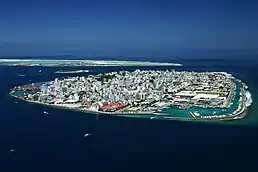
The tsunami of 26 December 2004 caused extensive damage to the Maldives - of a population of only 290,000, over a third was directly affected by the tsunami and more than 15,000 people were left homeless. The economic damage alone was over 62% of the GDP or US$470 million. The immediate response from international donors and agencies mobilized more than US$400 million in aid after the disaster, much of which was used to help misplaced persons rebuild their homes and infrastructure damaged by the waves.
Economy
Tourism, Maldives largest industry, accounts for 28% of GDP and more than 60% of the Maldives' foreign exchange receipts. Over 90% of government tax revenue comes from import duties and tourism-related taxes. Over 1.7 million tourists visited the islands in 2019. Fishing is the second leading sector. The Maldivian government began an economic reform program in 1989 by lifting import quotas and opening some exports to the private sector. Subsequently, it has liberalized regulations to allow more foreign investment. Agriculture and manufacturing continue to play a minor role in the economy, constrained by the limited availability of cultivable land and the shortage of domestic labour. Most staple foods must be imported. Industry, which consists mainly of shipping, boat building and handicrafts, accounts for about 18% of GDP. Maldivian authorities worry about the impact of erosion and global warming on their low-lying country; 80% of the area is one metre or less above sea level.
Culture
Maldivians are entirely Sunni Muslim, and the local culture is a mixture of Sinhalese, South Indian and Arab influences. While alcohol, pork, dogs and public observance of non-Muslim religions are banned on the inhabited islands, the resorts are allowed to exist in a bubble where almost anything goes.
Note that the weekend in the Maldives runs from Friday to Saturday, during which banks, government offices and many shops are closed. You won't notice this at the resorts though, except that lunch hours may be shifted for Friday prayers.
_6.jpg.webp)
Climate
The Maldives are tropical, with plenty of sunshine and temperatures around 26.4°C (79.52°F) to 31.5°C (88.7°F) throughout the year. However, rainfall increases considerably during the April-October southwest monsoon, particularly from June to November.
Read
- The Maldives: Islamic Republic, Tropical Autocracy by J. J. Robinson, a journalist who lived in the Maldives through some of its 21st-century political turmoil. In addition to an interesting look at what life is like for foreigners in Malé and for staff behind the scenes at the resorts, the book gives a detailed and surprisingly readable account of the complex political crises that the country experienced between 2008 and 2015.
Official tourist guide to Maldives
- Visit Maldives website
Talk
- See also: Dhivehi phrasebook
Maldivian (Dhivehi), a close relative of Sinhala (spoken in Sri Lanka) but with borrowings from Urdu, Hindi, Arabic and many other languages, is the official and national language. It is written in a remarkable hybrid script called Thaana, which uses Arabic and Indic numbers as the base of the alphabet, written from right to left with Arabic vowel signs. The script is thought to have originated as a secret code for writing magical formulas so that outsiders can't read them, which would also explain why the ordering of the alphabet is, as far as linguists can tell, random.
English is widely spoken, particularly by government officials and those working in the tourism industry. English is also the language of instruction in schools. "House reef" describes a coral reef accessible from the beach or jetty, thus you may hear discussions about whether an island has a good house reef or not.
Since the Maldives are a popular destination for German and Italian holidaymakers, a sizeable number of local resort workers speak German and Italian. This may vary depending between resorts.
Get in
Entry requirements
 |
Visa restrictions:
Israeli citizens are banned from entering Maldives. |
| (Information last updated Jun 2024) |
The Maldives have a remarkably easy visa policy: Everybody gets a free 30-day visa on arrival, provided that they have a passport valid for a minimum period of 1 month from the date of entry, a return journey confirmed ticket and entry requirements to the onward destinations, a prepaid confirmed hotel booking at a registered hotel or proof of financial means for sufficient funds to support the stay in Maldives (US$100 + $50 per day). See the Maldives Immigration website for details.
Traveller Declaration form must be filled in and submitted by all foreigners arriving to the Maldives, within 96 hours (4 days) to the flight time. The form has to be submitted electronically via IMUGA.
Importing explosives, weapons, firearms, ammunition, pornographic material, materials deemed contrary to Islam including ‘idols for worship’ and bibles, pork and pork products, and alcohol into the Maldives is forbidden and all luggage is X-rayed on arrival. Exporting sand, seashells or coral is forbidden. All dogs are banned from the Maldives. See the Maldives Customs Service website for details.
By plane

Practically all visitors arrive at Velana International Airport (MLE), on Hulhulé Island next to the capital city Malé. The airport is served by a wide array of flights from China, India, Sri Lanka, Dubai, major airports in South-East Asia, and charters from Europe. Many flights stop in Colombo (Sri Lanka) on the way.
If you want to get an amazing aerial view of the islands, try to get a seat on the left side of the flight.
British Airways flies directly from London Gatwick to Malé during the winter (October to March). No direct flights operate from London Heathrow, however, it is possible to get an indirect flight via India or the UAE for example. Singapore Airlines flies daily direct from Singapore to Malé, with late night timings.
Gan Airport (GAN), on the southern atoll of Addu, serves a few international flights.
Departure taxes are included in your ticket.
By boat
There are no regular passenger boats to the Maldives. Even yachts usually steer clear, as navigating around the reefs is hazardous and permits are expensive. Dogs are banned from the Maldives. Even if they remain on your boat the authorities can be extremely sketchy about this compromise, and this can put the life of your dog at risk, should the officials you are dealing with not be sympathetic to your situation. Be sensible and do not bring them into any Maldivian port.
Get around

There are four main ways of getting around in the Maldives: domestic flight, boat, seaplane and private yacht (liveaboard). The boats are the Maldivian equivalent of a car, while seaplanes and private yachts (liveaboards) are mainly reserved for tourists.
Seaplanes prefer not to operate at night, so if you arrive at the airport after dark and are going to a distant resort, you may have to spend the night in Malé, Hulhumalé or at the airport hotel in Hulhulé. Private transfers, though expensive can be opted for resort transfers, instead of spending the whole night at Malé City. Private transfers could cost US$500-800. On the way back, there may also be a significant gap between the time your transfer arrives and your flight departure. Check with your resort or travel agent.
By plane
No point in the Maldives is more than 90 minutes away by plane from Malé, and visitors to the more far-flung resorts use air taxi services. There are four main operators: Manta Air, Flyme operates scheduled flights from Malé to Maamigili, Dharavandhoo and Hanimaadhoo, Trans Maldivian Airways which flies DHC-6 Twin Otter seaplanes that take around 15 passengers. The company schedules most planes at 6PM the previous day. Delays are frequent, it is not rare to wait for 5 hours in the TMA lounge. Seaplane scheduled in the evening has a high risk of being cancelled as delays add up and the sky becomes darker, in such cases TMA will make you take a combination of domestic flight and boat, potentially making you reach your destination well after dinner time.
Scheduled inter-island services are provided by Maldivian, which flies from Malé to Gan, Maafaru, Thimarafushi, Dharavandhoo, Funadhoo, Fuvahmulah, Hanimaadhoo, Ifuru, Kaadedhdhoo, Kadhdhoo, kooddoo, Kudahuvadhoo, Maavarulu, Faresmathoda, Hoarafushi, Madivaru and Kulhudhuffushi. Travel permits are no longer required.
By boat
The taxi boats generally take tourists to and from the islands in the North and South Malé atolls. They come in all different shapes and sizes depending on the quality of the resort you stay, and the Four Seasons has a large enclosed motor cruiser with drinks and food, while the lesser resorts have open-sided dhoni fishing boats.
Public dhoni ferries and cargo boats are available for more the independent-minded and budget-conscious. The main operator is MTCC, who list schedules and fares on their website.
The previous system of requiring written invitations and Inter Atoll Travelling Permits (IATP) for those wishing to visit other islands has been abolished; you're now free to travel wherever you wish. IATPs are still required if you wish to dock your own yacht, see Customs for details.
By bus
There are a number of bus routes around the capital including those which connects with the airport. They are run by RTL.
See
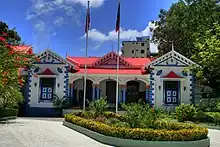
Most visitors come to enjoy the countless plush resorts, excellent beaches and stunningly colourful underwater life. Due to the isolated position of the island, the number of animals on land is limited, but the ocean has a wealth of wildlife. You will likely see plenty of anemones, different kinds of rays, octopus, squid and even giant clams. Whales, dolphins and turtles are spotted often. The Baa Atoll, named a UNESCO World Biosphere Reserve in 2011 and one of the richest coral reefs in the world is becoming the main tourist draw while also becoming an example of sustainable tourism in a protected area. In short; snorkelling or diving is an absolute must, see the Do-section below for more information.
The gorgeous and ubiquitous white sand beaches are a sight by themselves, especially with the tropical island setting they are in. A flight to one of the many resort islands gives spectacular aerial views of these picture-perfect islets, defined by rims of white sand and wide strokes of cobalt blue water.
Yet, if you can pull yourself away from your luxury holiday spot, the capital city Malé might be an interesting diversion. The bustling financial and political centre of the country has a few sights. Try the National Museum for a touch of history. While the building may not look too promising, the museum's fine collection includes beautiful Arabic and Thaana engraved woodworks, religious pieces, weaponry and other historic artefacts. The town also has a number of worthwhile mosques. The 17th-century Old Friday Mosque is the oldest one in the country, and officials are often willing to let polite and properly dressed visitors in. The Grand Friday Mosque & Islamic Centre is its 1984 modern counterpart, and dominates the city's skyline. While simple in design, the large, white marble structure and the shining gold dome is an attractive sight.
Do
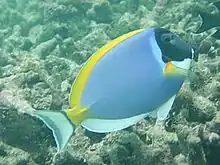
Diving and snorkelling
- Main topic: Diving in the Maldives
Aside from making the water bungalow rock on your honeymoon, the primary activity on the Maldives is scuba diving. The atolls are all coral reefs hundreds of kilometres away from any major landmass, meaning that water clarity is excellent and underwater life is abundant. Manta rays, sharks, even a few wrecks, you name it, you can find it in the Maldives.
While diving is very good by world standards even in the immediate vicinity of Malé, visibility and the chance of encountering large pelagic fish increases as you head to the outer atolls. Many divers opt for live-aboards, which can work out much cheaper than paying high resort fees. Currents vary considerably, with generally little inside the atolls but some powerful streams to be found on the sides facing the open sea. Water in the Maldives is warm throughout the year and a 3 mm shorty or Lycra dive skin is sufficient. Diving is possible throughout the year, but rain, wind and waves are most common during the season of the southwest monsoon (June-November). The best time for scuba diving is from January to April when the sea is calm, the sun is shining and the visibility can reach 30 m. There are decompression chambers on Bandos in Kaafu (15 min from Malé), Kuredu in Lhaviyani Atoll and at Kuramathi on Alifu.
The one downside to diving in the Maldives is that it's quite expensive by Asian standards. Prices vary considerably from resort to resort, with specialist dive resorts offering better prices. In general, a single boat dive with your own gear cost around US$50, and US$75 without. Beware of surcharges: you may be charged extra for boat use, guided dives, larger tanks, etc. On the upside, safety standards are usually very high, with well-maintained gear and strict adherence to protocol (check dives, maximum depth, computer use, etc.) being the rule rather than the exception.
Hanifaru Bay is a protected biosphere by UNESCO and is famous for some of the largest congregations of manta rays on the planet.
Surfing
The Maldives is becoming an increasingly popular surfing destination. Turquoise water and perfect waves make it an ideal and uncrowded destination for surfers looking for smooth surfing conditions.
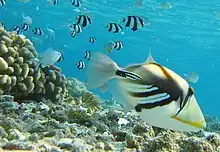
The best period for surfing in the Maldives is between March and October; the biggest waves occurring in June, July and August. This paradise is exposed to the same swells as Indonesia is, except that its higher latitude and its South-East exposure offers cooler and less hardcore surfing.
The O’Neil Deep Blue Contests held in the Maldives have placed Maldives firmly on the world’s surf map. While most of the recognized surf breaks are in Malé Atoll, there is certainly more to be discovered.
Specialized companies organize tailored multi-day boat trips in the region, allowing surfers to move easily from one point to another and maximizing the surfing time.
Buy
Money
|
Exchange rates for Maldivian rufiyaa
As of January 2024:
Exchange rates fluctuate. Current rates for these and other currencies are available from XE.com |
The local currency is the Maldivian rufiyaa, denoted by the symbol "Rf" or "MRF" (ISO code: MVR). It is divided into 100 laari. However by law, resorts price services in US dollars and require payment in hard currency (or credit card), so there's no need to change money if you're going to spend all your time at the resorts. Most hotels have a shop but this is limited to diving and holiday essentials (sun cream, sarongs, disposable cameras, etc.) Some excursions from resorts will take you to local islands where there are handicraft type things to buy, but they are typically made outside the Maldives and sold at significant markups.
Coins come in denominations of 1, 2, 5, 10, 25 and 50 laari, 1 and 2 rufiyaa. Banknotes come in denominations of 5, 10, 20, 50, 100, 500 and 1,000 rufiyaa. The current series of rufiyaa banknotes is printed entirely on polymer.
If you are heading to Malé City or the other inhabited atolls, exchanging some rufiyaa will come in handy. The coins, in particular, are quite attractive and make an interesting souvenir in themselves, but the smaller denominations are rarely used or seen. The rufiyaa is tied to the US dollar within a 20% band but is practically 15:1. US dollars are near-universally accepted: shops usually exchange them at 15:1 or 10:1.
Maldivian rufiyaa can be changed at Bank of Maldives in the arrival area of airport. If you want to change rufiyaa back to your currency before departure, you need to keep the receipt. After check in, at Bank of Maldives in the departure area of airport, you can change rufiyaa back to the currency you previously changed to rufiyaa, not exceeding the amount listed on the receipt. The Bank of Maldives may not have small notes of your original currency though.
Tipping
Tipping is not compulsory in the Maldives as a 10% service charge is added to everything, although it is not certain that the money is passed on to the staff.
Over the years the tipping culture has changed in the Maldives, mainly due to overseas visitors giving varying amounts of cash as tips.
Costs
Maldives is expensive for those who have comfort and service-oriented tourism in mind. Resorts have a monopoly on services for their guests and charge accordingly: for mid-range resorts, US$1000 per week per couple is a conservative budget for meals, drinks and excursions, in addition to the cost of flights and accommodation. Practically anything, including hotel rooms if booked locally, has a 10% "service charge" added, but tips are expected on top.
For an adventurous traveller who has time, Maldives can be a very affordable and rewarding experience, with prices comparable to Malaysia. A number of inhabited islands have guesthouses with typical prices €25-40 per room. On more remote islands, renting rooms in villages is possible at even less. Food is inexpensive, and fish curries are delicious. Public ferries will transfer you between different islands of the same atoll for a few US dollars (though for less obvious locations, there will typically be 1 ferry per day and no ferries on Fridays). For transfers to remote atolls, one can negotiate with cargo boats, which would often take people for €14-38, depending on the destination. Cargo boats do not have schedules and depart when loaded. One may expect 1 boat in 1-3 days for each atoll.
It is important to have in mind that staying on inhabited islands implies respecting the strict Muslim norms including no alcohol, modest dress, reserved behaviour. However, the locals are very welcoming and the experience may be much deeper and more rewarding than staying in resorts.
Eat
All the resorts are self-contained so they have at least one restaurant, which generally serves the type of cuisine expected by their guests (i.e. modern European or generic Asian). Breakfast is almost always included, and most resorts offer the option of half-board, which means you get a dinner buffet, and full board, which means you get a lunch and dinner buffet. These can limit the damage compared to ordering a la carte, but your options are typically very limited and drinks are often not covered, not necessarily even water. If you're planning on drinking a lot, it may be worthwhile to go all inclusive, but even this typically restricts you to house drinks.
The only other place to find food is Malé City. This comes in two forms. Either small restaurants aimed at the tourists (of which there are a couple of nice Thai restaurants), which are often expensive, or small cafes called hotaa, selling local Maldivian food at prices as low as Rf20 (US$6) for a complete meal.
Maldivian cuisine
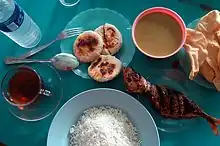
Maldivian food revolves largely around fish (mas), in particular tuna (kandu mas), and draws heavily from South Indian tradition, especially Kerala. Dishes are often hot, spicy and flavoured with coconut, but use very few vegetables. A traditional meal consists of rice, a clear fish broth called garudhiya and side dishes of lime, chilli and onions. Curries known as riha are also popular and the rice is often supplemented with roshi, unleavened bread akin to Indian roti, and paaparu, the Maldivian version of crispy Indian poppadums. Some other common dishes include:
- mas huni — shredded smoked fish with grated coconuts and onions, the most common Maldivian breakfast (eat it as is or wrap it in roshi)
- fihunu mas — barbequed fish basted with chili
- bambukeylu hiti — breadfruit curry
Snacks called hedhikaa, almost invariably fish-based and deep-fried, can be found in any Maldivian restaurant.
- bajiya — pastry stuffed with fish, coconut and onions
- gulha — pastry balls stuffed with smoked fish
- keemia — deep-fried fish rolls
- kulhi borkibaa — spicy fish cake
- masroshi — mas huni wrapped in roshi bread and baked
- theluli mas — fried fish with chilli and garlic
Drink
As the Maldives is a Muslim country, alcohol is banned from the local population, as is with the importation of such products. At Velana International Airport, customs scan baggage through x-ray screening and will confiscate any bottles of alcohol they find. They will then issue a customs receipt, which you must carry with you at all times in order to reclaim your bottles before you leave the Maldives. However, nearly all resorts, live-aboard boats and the Hulhulé Island Hotel (on the same island as the airport) are licensed to serve it, usually with a steep markup.
Tap water in resorts may or may not be drinkable: check with the management. Bottled water is extortionately priced, with US$5/bottle being typical.
Sleep
| This guide uses the following price ranges for a standard double room: | |
| Budget | Under US$100 |
| Mid-range | US$100-300 |
| Splurge | Over US$300 |
The Maldives had a longstanding policy of keeping tourists on dedicated islands, which meant they could only stay in full-service resorts where the cost of a night's accommodation started around US$200 and went up into the stratosphere, and the vast majority of visitors continue to opt for these. However, from 2008 all the islands were opened to tourism, and backpacker-friendly guesthouses starting from US$30 a night opened on inhabited islands across the archipelago.
Resorts
Most resorts take up their own island (1500 x 1500m to 250 x 250m), meaning that the ratio of beach to guests must be one of the best in the world and it is hard to imagine that you would ever have to struggle to find your own private piece of beach to relax on. Many have a "no shoes" policy and with such soft sands, it is easy to love this idea.
The range and themes or the resorts are impressive, and most people will find one they like. They can be grouped into three types:
- Dive resorts, designed primarily for divers. Geared expressly for people who want to spend most of their time underwater, facilities on land are limited, but the house reef is usually excellent. Often found in the more far-flung parts of the archipelago.
- Holiday resorts, designed primarily for families. These are large and have a full complement of facilities (several restaurants, day-care centres, etc.), but don't have the over-the-top luxury and have less privacy. Most of these are located on Kaafu, with easy access from Malé City.
- Luxury resorts, designed primarily for honeymooners and the jet set. The place to be if you want designer furniture, gourmet food and a plasma TV in an overwater villa reachable only by rowboat, and are willing to pay high prices for the privilege.
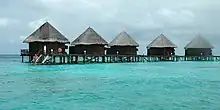
A Maldivian classic is the overwater bungalow, built on stilts directly above a lagoon. While these look fabulous and sound appealing, they have their downsides:
- They're usually packed tightly together, often sharing a wall, meaning little privacy.
- Especially at low tide, the water level may be too low to allow swimming or snorkelling.
- Resort facilities may be a fair distance from the bungalows.
- The lapping of waves is romantic enough on a calm day but can make it next to impossible to sleep if a storm blows through.
These factors vary from resort to resort, so research carefully. A good one is definitely worth trying at least once, but many Maldives repeaters prefer a bungalow with a private beach.
When considering where to go, factor in transport time and costs from the airport: the more far-flung resorts generally require an expensive seaplane transfer and you may have to stay overnight at the airport on the way. On the upside, the further away you are from Malé, the more peaceful the islands and the better the diving.
Many resorts, especially the smaller dive-oriented ones, cater largely to a single nationality, leading to "Italian" resorts, "Dutch" resorts, "German" resorts, etc. While almost all welcome any nationality and have some English-speaking staff on hand, you may be cut off from any evening entertainment and have problems e.g. diving if you don't speak the local lingo.
Guesthouses
There are guesthouses on inhabited islands, and Maafushi island is popular with looking for hassle-free accommodation of this type. Low-end prices are €25-35 per night.
Examples include: Equator Village on Addu Atoll, a former British Royal Air Force base converted to a 78-room hotel. The cost is around US$100-150 per person per day all-inclusive (including some alcohol). Another unique location is Keyodhoo Guest House, this guest house is on top of a recreation centre built by an Australian after the tsunami (US$20 pp/per night). Most visitors are scuba divers or adventure travellers. Other Inns/B&B can also be found on Vaavu Atoll, Dhaalu Atoll, Kaafu Atoll, North/South Malé Atoll and Ari Atoll Hangnaameedhoo. Only a few of these inns and B&Bs have their own pool. Confirm if bikinis are allowed on the beach. The distance between the inns and beaches are usually short, but visitors should still dress appropriately to Maldive customs.
Village homestays
More independent-minded travellers and those looking for cultural experience may consider renting rooms in villages. This will require either walking through the village and asking around if you're particularly confident of your social skills or inquiring in Malé City whether someone can put you in contact with their friends or relatives on a remote island for such an informal homestay. Prices can be as low as €15 per night for a clean functional room.
Learn
The first university in Maldives (Maldives National University) was inaugurated on 15 February 2011. Operated under the aegis of the Department of Higher Education and Training, MCHE and the Islamic University of Maldives are the only free public degree-granting institutions on the island. The college offers a range of degrees, diplomas, and certificates, with particular emphasis on engineering, health science, education, tourism, and management. The average enrolment at MCHE is around 4,000 students in long-term (that is, more than one academic year) programs and around 2,000 in short-term (shorter than one academic year) courses. State-owned institutions such as Maldives Polytechnic and TVET Maldives offers free technical and vocational training to help develop skills for employment. Several private institutions offer internationally recognised undergraduate and postgraduate courses.
Work
Getting a job in the Maldives can be tricky. It is not the kind of place where you can just turn up and start job hunting. Generally, the resorts take on a mix of local and international staff so you need to approach the resort Human Resources departments. There is a good mix of jobs but a lot of the roles are diving based (divemasters, instructors, photographers, etc.)
Most resorts are predominately one or two nationalities so finding the resorts that match your language skills helps. After that experience always helps (especially for diving instructors as the Maldives are well known for their strong currents and half of the time the currents will take you straight out into the Indian Ocean).
Generally, if you get a job with a resort then they will get you a work permit and pay for your flight, food and accommodation. They don't really have much choice, it's hardly as if you can pop out to the supermarket and pick up a pizza for dinner.
Stay safe
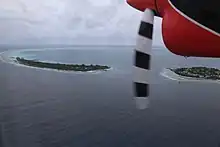
Dial toll-free number 1478 or (+960) 9790070 to contact the tourist police at anytime for information or assistance.
Most visitors to the Maldives stay in “resort hotels” where crime levels are relatively low. Nevertheless petty crime, including the theft of goods left unattended on the beach or in hotel rooms, does occur. You should take care of your valuables and other personal possessions, especially when travelling in Malé City. Use safe deposit boxes on island resorts.
The sea around the Maldives can have strong tidal currents and a number of tourists drown every year. You should always take local advice before entering the sea.
You should be sensitive to local dress standards when on local islands or if staying on an island where the resort is not the exclusive property on the island – cover your shoulders and avoid short or tight-fitting shorts (men and women). Bikinis are only allowed in a designated area on some local islands. Nudism and topless sunbathing are not allowed anywhere, including on resort islands.
Maldives has very strong anti-drugs laws. Importing or possessing drugs can carry severe penalties, including life imprisonment. Locals and police are likely to treat seriously the possession and consumption of alcohol, and being intoxicated, outside resorts and liveaboards.
Same-sex relations are illegal and convicted offenders could face lengthy prison sentences and fines.
Cases of sexual harassment are not rare in Maldives. Solo female travellers should be vigilant.
Blasphemy, criticism of Islam and proselytizing by non-Muslims in Maldives, including the public possession and distribution of non-Muslim religious materials (such as the Bible), is illegal.
Stay healthy
Health facilities are established in each inhabited island with island level primary health centres, followed by a higher level of health facilities and speciality care hospitals at the atoll level, and tertiary care facilities at the urban/city level. If you fall seriously ill during your stay, you may be transported to another country for adequate medical care.
There are no serious problems with diseases in the Maldives. Beware that tap water may not be drinkable at all resorts: enquire locally. The Maldives are malaria-free, but some islands do have mosquitoes and catching dengue fever from them is possible, albeit highly unlikely. For those coming from regions infected by yellow fever, an international certificate of inoculation is required.
Most of the problems come from diving or sun-related injuries. Heatstroke always causes problems in the tropics but couple that with divers spending hours at a time on a boat wearing a wetsuit and overheating of one form or another is a real issue. Keeping this in mind, such injuries will be easily avoidable as long as you drink lots of water and get into the shade as much as possible.
Lots of the resorts have their own doctor or nurse and most are within easy reach of the decompression chambers. Malé City has efficient and fairly modern hospitals but bear in mind that it is a long way to get medically evacuated home from.
Respect
|
Ramadan
Ramadan is the 9th and holiest month in the Islamic calendar and lasts 29–30 days. Muslims fast every day for its duration and most restaurants will be closed until the fast breaks at dusk. Nothing (including water and cigarettes) is supposed to pass through the lips from dawn to sunset. Non-Muslims are exempt from this, but should still refrain from eating or drinking in public as this is considered very impolite. Working hours are decreased as well in the corporate world. Exact dates of Ramadan depend on local astronomical observations and may vary somewhat from country to country. Ramadan concludes with the festival of Eid al-Fitr, which may last several days, usually three in most countries.
If you're planning to travel to Maldives during Ramadan, consider reading Travelling during Ramadan. |
Much of what is considered good manners in South Asia is applicable to the Maldives.
Maldives is a highly religious country and local laws reflect the fact that the country is an Islamic country. You can very easily elicit strong responses by speaking negatively about religion, especially from an agnostic point of view.
Connect
There are two mobile operators: Dhiraagu and Ooredoo. Both of them sell local prepaid SIM card or eSIM with the internet connection at competitive rates. The first-mentioned of them is the leading local telecom company which has wider coverage while prices are about the same with its competitor. They both have shops right next to the airport arrivals area upon exiting. Also, both offer 3G/4G/5G data connections. Also if you plan to sail maybe you can be interested in satellite service offered by Ooredoo.
Most hotels and cafés offer public Wi-Fi but connections are usually slow. A local mobile number is needed to purchase time at many Wi-Fi hotspots around the country.
Emergency services
Dial 119 or (+960) 3322111 for police, (+960) 3322211 for flight information, 118 for fire and rescue, and 191 for coast guard.